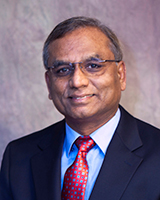Request Username
Can't sign in? Forgot your username?
Enter your email address below and we will send you your username

ASCE Publishing: What separates this journal from others in the field?
Surampalli: This is the only journal in the world that publishes peer-reviewed articles about hazardous, toxic and radioactive wastes (HTRW). This laser focus on papers that have engineering relevance with significant novelty and scientific impact makes it stand out from the crowd. For example, this journal is one of the few places for articles about planning and management of HTRW. The journal also publishes review articles related to research, treatment, remediation, development, planning and management of HTRW. The articles published in this journal are actual field studies encompassing the wide field of HTRW. The journal reports both successes and failures in the various topics under its wide scope. Therefore, it has helped in enhancing the practical knowledge and applicability of various techniques in the field of HTRW.
ASCE Publishing: What are the hot topics in your space that you want to cover?
Surampalli: Our editorial board looks to cover basic and applied research on HTRW, such as elimination, management, remediation, modeling, treatment and disposal of hazardous, toxic, nuclear, biomedical, pharmaceutical, industrial wastes, and their fate/transport and behavior in the environment. We also seek topics relating to human exposure and health effects; and waste minimization, recycling, and beneficial reuse of waste materials. Perhaps, “emerging pollutants–nanoparticles, pharmaceuticals, industrial chemicals, etc.” is a category of pollutants about which the knowledge bank is not much available. Also, we would like to see more articles on emerging environmental pollutants published in this journal.
ASCE Publishing: What key features do you look for in an article submitted to your journal?
Surampalli: Articles should have some novelty as well as significant impact and implications to the areas related to HTRW. Our emphasis is on articles of interest to both fundamental researchers and practicing engineers. Moreover, the work should be able to add something of importance or applicability to the already existing body of work. Lastly in today’s age, many people from the non-scientific community or fields unrelated to the target audience are interested in expanding their knowledge or read a journal just because of sheer interest. We would therefore want the article to be self-explanatory to not just the core audience but also to others.
ASCE Publishing: What are your aspirations for the future of the journal?
Surampalli: My goal is for this journal to be recognized by our peers as unique and having the highest authority in the field of HTRW. I would note that the quality of articles submitted to this journal has improved significantly in the last five years or so. Being a peer-reviewed journal, the HTRW journal collects high-quality research output, which makes it a superior platform for researchers. This journal already has a global reach and we see significant international submissions, particularly from India, China and other developing countries. I hope that in the future, the journal reaches even greater readership by increasing its scope and including upcoming problems like emergent pollutants as already mentioned earlier. In addition, the editorial board wants to publish special issues routinely on current and important topics relating to HTRW. ASCE Publications has evolved with the times from hardcopy submission to online submissions and thus making the review faster. We are doing our best to get quality papers published soon, and further improve and shorten the review period.
ASCE Publishing: What drew you to Civil Engineering? What drew you to being an editor?
Surampalli: What a civil engineer does can be seen by everyone and will affect people’s daily life in a positive way. Being a civil engineer makes you feel right. I had passion for engineering, and I am very fascinated with environmental engineering and science fields. It is a great honor to be an editor of an ASCE journal, and I enjoy working in the interdisciplinary aspects of environmental engineering and science.
ASCE Publishing: What changes in your field have you seen during your tenure as editor?
Surampalli: The changes I have noted in my field, include: 1) more new remediation technologies developed; 2) many works focus on MS4 or stormwater treatment/management; 3) combination of watershed approach and environmental engineering; and 4) more fancy (cutting-edge) analytical methods are used (e.g., DAN/RNA or omics techniques for identifying microbial communities).
During my tenure as editor, I have also seen many changes, such as: 1) the manuscript quality has been improved significantly, and more in-depth papers are there in each issue; 2) more review manuscripts being published (almost one review paper per issue); 3) more special issues on some special topics (e.g., hazardous nuclear waste, landfills, air pollutants, etc.); 4) the associate editors are of more international diversity; 5) the reviewers do their reviews faster with higher quality than before; 6) more Asian researchers (e.g., India, China, Korea, etc.) are participating in the review process; and 7) more American companies published their application-oriented papers (often based on their real-world projects) in the journal.
ASCE Publishing: What challenges are researchers facing today / in the coming years?
Surampalli: Research funding is a major problem. Researchers need to be innovative on research collaboration, and reach out to practitioners, other universities and international collaborators from abroad. The other challenges that researchers face today are often related to time, cost, and the role of big data and technology. But on the other hand, these challenges are unique opportunities for experimentation and innovation. In addition, access to journals can be a big problem in developing countries.
ASCE Publishing: Any advice for new researchers starting out?
Surampalli: I encourage all researchers to:
Learn more about contributing to the Journal of Hazardous, Toxic and Radioactive Waste.